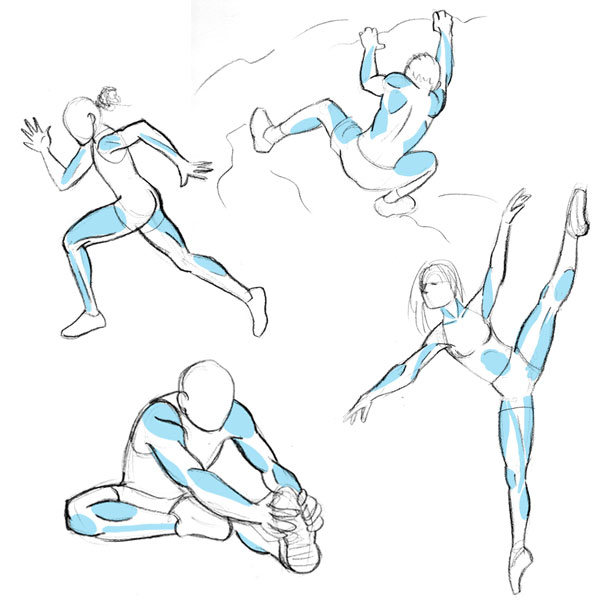
For the past few sessions we have become thoroughly familiar with the general structure and posture of the body in a range of variations. Now we’re ready to clothe it with flesh, and above all that means the muscles layer, since that defines how things look on the surface.
Understanding What Your Need to Draw
Learning to draw muscles may conjure medical charts in daunting details, but such complexity is unnecessary. We only need to know what shows up through the skin, since that’s what we draw: in real life, you’d have to look hard to find someone whose body displays intense muscle detail (basically bodybuilders and some athletes). Similarly, it is only a niche of illustrators who give a lot of attention to muscle details in their work, such as artists for superhero comics.
Therefore it is quite enough to start with a simplified understanding, and move on to medical charts later if one feels the need!
In the diagrams below, I’ll be showing muscle groups in color, with a black line to show the forms that would show through the skin (I also show protruding bones that would do the same).
We all have a layer of fatty tissue under our skin, and this softens the look of the underlying muscles. Take an angular object, such as a box, and cover it with thin fabric, such as a bedsheet. Note how the angles look now. Then cover it instead with a thick bathing towel. See how all sharpness disappears? This is what happens in the body.
Now this layer of fat, comparable to that thick bath towel, is generally thicker in populations that originate in colder places, and it’s also thicker in females than in males, while males naturally have more muscle mass. Beyond that, an individual’s personal story creates infinite variation. You can be very muscular but have a thick layer of fat that makes you look deceptively soft. You can be skinny and have no muscle mass to talk about. You can have an average muscle mass, but so little fat everything looks chiseled (the “sinewy” look). And everything in between.
Muscles Guide
Quick Notes On Muscle Behavior
- A muscle’s job is to pull together the points to which its ends are attached. This simple fact can help you deduce what movement a given muscle is associated with.
- An active (contracted) muscle bulges and is hard (this is to a light degree: the more effort involved, the more it bulges).
- An inactive (relaxed) muscle does not bulge and can be quite limp to the touch.
- A muscle can only pull, not push: to return to its original position it needs an opposite (antagonist) muscle to pull in the opposite direction. So most muscles in the body come in antagonistic pairs, and when one in the pair is contracted, the other is necessarily relaxed. For instance, if you bend your leg, the muscle whose job it is to un-bend it cannot be bulging, and vice-versa. (You can deliberately contract all your muscles, for instance to block a blow, but no movement is possible while you do.)
Understanding the above means that, no matter what movement you draw, you’ll always know the correct muscles that should be bulging. Then you won’t end up with something haphazard and anatomically nonsensical. Here’s an illustration of how the position of a limb does not determine the state of the muscles, only the movement does:

In the diagrams below, when you see muscle names that are the same color, it means they are an antagonistic pair and should not be both drawn bulging at the same time.
The Torso
Below are the muscles in the torso and on the back that you need to be aware of. Note also two bones:
- The clavicle bone which is always a prominent feature unless an unusually thick layer of fat erases it.
- The shoulder blades, which are prominent unless the back muscles are so developed they cover them up. The visibility of the shoulder blades also varies with arm movements, torso bent, and other movement, so observation from life is useful for this detail.

Obviously, as I’m showing all the possible muscle lines, the result is a very ripped body, whereas softer bodies would show less lines: compare below our original model, with muscles muted to show the lines better, and a more average figure where only a few still show, with the shoulder blades more prominent than the back muscles. Note also less bulky shoulders and a waist that’s less thin. This goes for females as well, except that their pectoral muscles are hidden behind the breasts, so they can be replaced by them altogether in drawing.

The Arms
Using another muscular example, here is the arm:
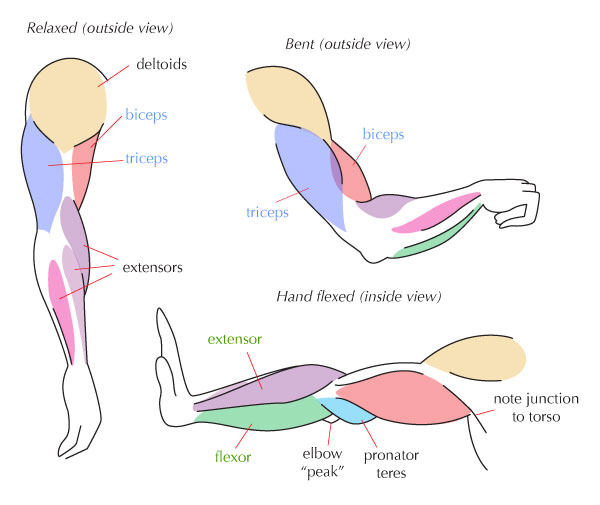
In an average arm, this underlying structure translates as this contour:
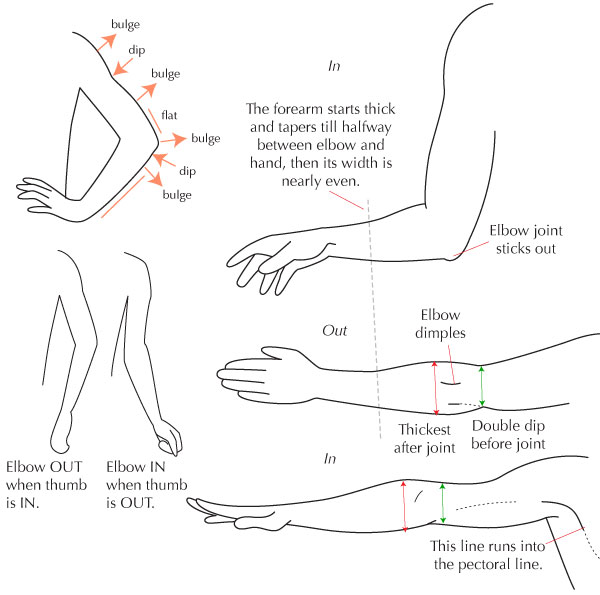
The Legs
In the legs below, two more bones are to be noted: the patella (knee cap) and the tibia, which defines the front of the lower leg; indeed there is hardly any muscle there. It’s why a kick in the shins is so terribly painful – no cushioning. One can have powerful, hyper-developed calves, but their antagonist, the tibialis anterior, will never grow to the same extent.
Note also that the ankle bone juts out on both sides of the foot, but is higher on the inside. Finally, Achilles tendon, as its name indicates, is not a muscle: though it can be sharply defined in a body with developed leg muscles, it can never be contracted, i.e. bulge like a muscle (its role is to anchor the muscle to the bone, not itself move).

Body Fat
As mentioned above, we all have a layer of fatty tissue under the skin. It can be really thin in our most ripped athletes, and disappears altogether in starved bodies, but even healthy bodies have it – in fact it is what makes us think of a body as healthy, as opposed to “skin and bones”.
In addition to this, fat reserves are stored in certain parts of the body, and these are not the same in males and females! As shown below, females store fat in their underarms, thighs and buttocks, while males do in the belly.

Does this mean they don’t put on fat in the rest of the body? No, it only means that this is what “fills up” first. A slim female who puts on weight will first notice it in her backside and thighs (aka “can’t fit into my jeans!”), then under the arms, and a male will first see a “beer belly” appearing (inversely, when losing weight, these parts are the last ones to go, if they do at all.)
Then if the weight increase continues, the fat under the skin grows along with the fat reserves, and we see the weight piling up all over the body. Finally, in extreme cases, there is inflation everywhere the skin is willing to stretch.
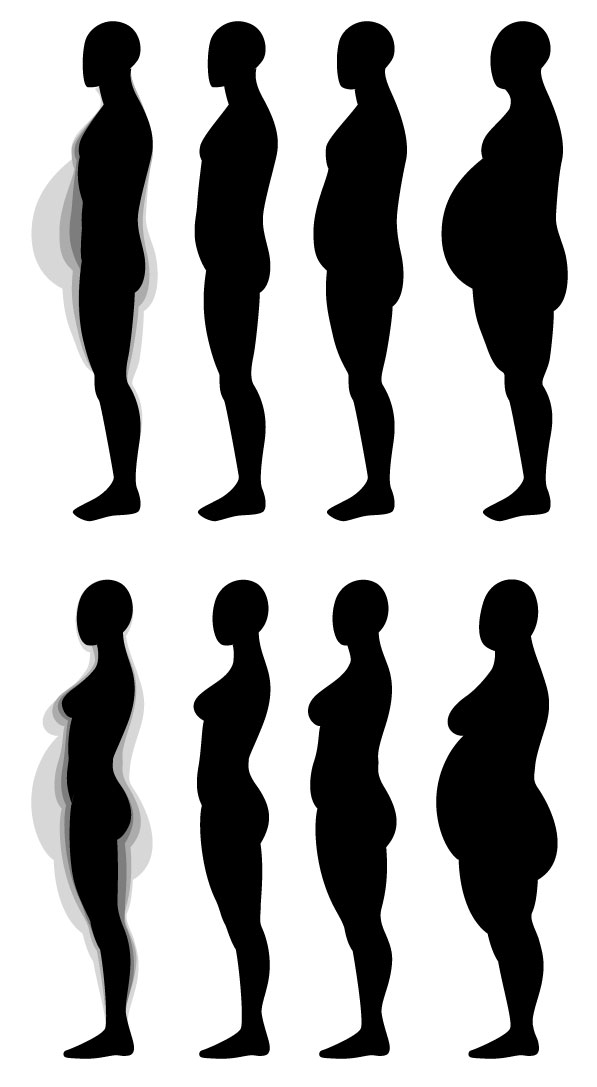
Note also:
- The tendency to store fat increases when we hit our forties.
- Post-menopause, a woman’s fat reserves are redistributed to the belly and follow the male pattern.
Breasts
One more body mass that needs to be understood: female breasts. You’ll earn the respect and thanks of slightly over half of humanity by drawing them as they are, rather than as they appear in mainstream comics and manga.
First a few words about anatomy: breasts are not bags of soft tissue. They are a gland, so there is a hard mass in there, surrounded with soft fatty tissue. This also means they have weight and that they react to gravity. The proportion of fatty tissue means they do increase or decrease in volume as the body gains and loses weight; what’s more, intense exercise goes hand in hand with a reduction of the chest, which can be slight or dramatic (as can be observed in female athletes, particularly those who started training before puberty.)

Breasts come in all sizes and shapes, so it’s not easy to give proportions and guidelines. So, just as we did with the 8-head-tall figure, we’ll start with what Western society considers a perfectly proportioned breast, as detailed in reconstructive surgery guidelines:
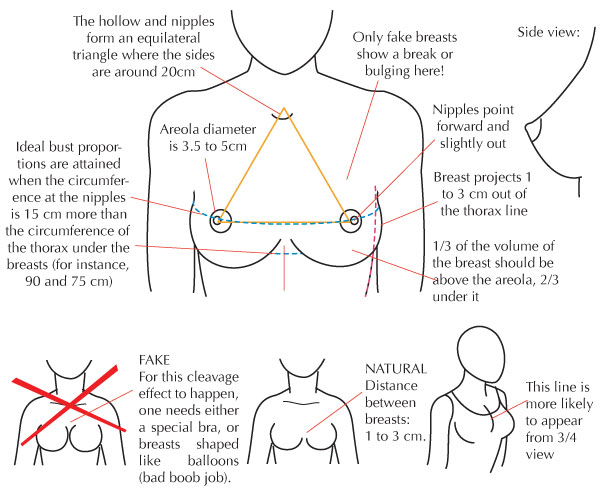
This very brief exposé is meant to put you on the right track. I realize it’s nearly impossible to find references for random, natural-shaped breasts when search engines only yield questionable results and roundabout sources (like lingerie websites) only feature chests that display their products to their best advantage. But one can observe, without being creepy please, fully-clothed females and how that part of their body behaves and affects their posture.
Practice Time
We have covered a lot of detailed material in this session that requires taking in. Stand in front of a mirror and find each of the muscles shown here in your own body. It’s not essential to memorize their names, the point is to become aware of what’s there (if you do sports, you’re probably already aware of quite a few).
You may find you have to move in certain ways, or contract certain parts, or stand in a certain relation to the light, for some of them to be guessed. This is the best possible way to absorb and make sense of this material, as muscles make up a very dynamic aspect of the body that the best charts in the world cannot truly convey. Understanding them and what they do from the inside, empowers you to understand the underlying structure of other bodies you observe, and to draw them without having to guess.
Look at photos of people, still or in motion, whose muscles are readily visible. Sketch them as you see them and use a different color to draw the muscle – all of it, hidden under the skin, in a simplified shape. Also mark jutting bones and such.
Once you’re gaining confidence, do the same with less lean models where you have less outside clues. At what point is there no hint left of the structure beneath?
Sketch from scratch, as we’ve been doing with our basic stick figure, now fleshing it out with a muscle body and a contour of skin, not forgetting breasts for female figures.

{excerpt}
Read More